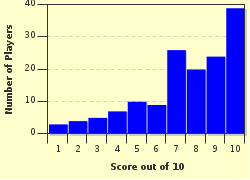Quiz Answer Key and Fun Facts
1. An iconic figure in Irish Republican history, who was this Belfast man who spent nearly all his adult life in jail, was elected as an MP to the British Parliament, and died in 1981 after 66 days on hunger strike for political status?
2. Associated with the North Antrim town of Ballymena as well as with Belfast, which larger-than-life political cleric, famously linked with the slogan 'Ulster Says No!', founded his own church in 1951 and the Democratic Unionist Party in 1971?
3. The paramilitary Ulster Volunteer Force member Lenny Murphy led one of the most feared Loyalist killer gangs in the 1970s, responsible for at least 30 killings in North and West Belfast. Many of his victims were horribly tortured with knives. By what name was Murphy's gang widely known?
4. Regarded as the principal Irish Republican strategist since the 1970s, who was the Sinn Féin Member of Parliament for West Belfast who was once part of an IRA delegation to secretly meet the British government in 1972?
5. Which international statesman's important contribution to supporting the Northern Ireland peace process was symbolised when he switched on the lights of Belfast's Christmas tree in 1995?
6. Another notorious Loyalist gangster was Johnny Adair, who ran the Ulster Defence Association's 'C' Company on Belfast's Shankill Road, believed to have been responsible for up to 40 killings of Catholics. When he eventually fled Belfast amidst an internal Loyalist feud, he left behind his Alsatian dogs, Rebel and Shane - to whom he was said to bear some resemblance. By what nickname was Adair fittingly known?
7. Which leading Marxist and Irish Republican led the Belfast dock workers' strike in 1911, and unionised women mill workers across the city, before going on to help lead the Easter 1916 Uprising in Dublin and being executed by a British firing squad?
8. In March 1988, a Belfast IRA Volunteer, Mairéad Farrell, along with some colleagues, was shot dead by the British SAS at the Shell petrol filling station on Winston Churchill Avenue. The IRA appeared to have been planning an attack against British soldiers. By what collective name did Mairéad Farrell and the other dead IRA members become known?
9. In 2006, a high-profile Loyalist paramilitary, Michael Stone, was arrested as he entered Stormont parliament buildings in Belfast, fully armed, to kill Republican leaders Gerry Adams and Martin McGuinness. Before entering the building he first daubed a graffiti slogan on its walls. During his trial how did Stone bizarrely describe his apparent murder bid?
10. Let's end on a less serious note. Cave Hill mountain towers over the northern approach to Belfast, shaped like a sleeping giant. Which 18th century political satirist is rumoured to have drawn inspiration from Cave Hill for his most famous 'giant' novel?
Source: Author
dsimpy
This quiz was reviewed by FunTrivia editor
stedman before going online.
Any errors found in FunTrivia content are routinely corrected through our feedback system.

